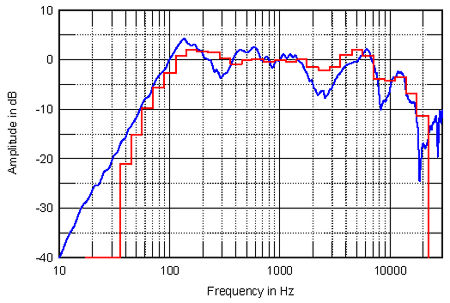| Columns Retired Columns & Blogs |
Bohlender-Graebener Radia 520i loudspeaker John Atkinson, January 2005
John Atkinson wrote about the Radia 520i in January 2005 (Vol.28 No.1):
When I measured the Radia 520i loudspeaker for Larry Greenhill's review in the December issue (p.115), I was bothered by the apparent unevenness of the 50" ribbon unit's frequency response. This unit covers the region above 400Hz, and its output was marred by roughly equal dips and peaks up to about 15kHz, above which it rolled off steeply. The microphone was placed 50" away from the speaker on an axis level with the midpoint of the ribbon for the quasi-anechoic measurement, and, as I wrote, this may well not have been far enough away to properly characterize the drive-unit's behavior. (The inherent assumption when measuring a loudspeaker's response is that the microphone is much farther away than the longest dimension of the speaker. With a 6'-tall speaker such as the Radia, that condition cannot realistically be met.)
I therefore set the review samples up in my own listening room, both for a weekend of auditioning and to carry out a spatially averaged response of the speakers' output at the listening position. (I average 120 individual 1/3-octave response measurements for each speaker driven on its own in a grid 18" high and 36" wide centered on the position of my ears.)
The results are shown in fig.9. The blue trace is the quasi-anechoic farfield response published in the December review, taken with a calibrated DPA omnidirectional microphone and DRA Labs' MLSSA system. The peaks and dips mentioned earlier are readily apparent, though it should be noted that the energy excess at 125Hz is an artifact of the nearfield measurement technique used to generate the trace below 300Hz.
The red trace is the spatially averaged response in my room, which takes into consideration the reverberant field, which in turn depends on the speaker's radiation pattern. (I used an AudioControl SA3050A spectrum analyzer, with its own calibrated microphone, for this measurement.) As Dr. Greenhill found, the speaker's mid- and low-bass output is prematurely rolled off, though in a well-controlled manner. The 520i is thus a natural match for a subwoofer. The unevenness in the anechoic on-axis curve can also be seen to smooth out, and the in-room response actually meets commendably tight ±2dB limits from 125Hz to 7kHz. Above that frequency, the Radia 520i's output falls off rapidly, pretty much mapping the anechoic curve.
Listening to the Radias (footnote 1), I was impressed both by the superbly defined, stable stereo imaging and by the smoothness of the sound. Bass was missing in action, but this was offset by the fact that there was no sense that the audioband was being covered by disparate drive-units. The integration between the twin 6.5" cone woofers and the ribbon was very well implemented.
However, while the suppressed top octave was not an issue for much of the time with both classical recordings and the usual overcooked modern rock discs, the lack of "air" in the Radia 520i's balance did occasionally intrude on recordings with naturally balanced high frequencies, such as the chamber-music recordings on my Editor's Choice CD (Stereophile STPH016-2). More important, I was sometimes bothered by a narrow band of brightness. This was audible, for example, as an added edge to the sounds of the solo voices on last September's "Recording of the Month," the Nikolaus Harnoncourt/Concentus Musicus Wien performance of Mozart's Requiem (SACD, Deutsche Harmonia Mundi 82876 58705 2). This balance correlates with the presence-region dip and the slight excess of energy in the mid-treble in the in-room response, my ear latching on to the latter as brightness rather than on to the former as a lack of presence. The opposite could also happen: Eric Clapton's Me and Mr. Johnson (CD, Reprise 48423-2) sounded too polite (though it must be said that Mr. C. does sound asleep at the wheel for much of this set).
Larry Greenhill summed up the Bohlender-Graebener Radia 520i as providing "clean, nonfatiguing sound, superb soundstaging that placed the instruments and voices with rock-solid stability, a wide dynamic range, and overall transparency." I'd say he basically nailed it, though I would want more top-octave energy.—John Atkinson
Footnote 1: My system comprised Mark Levinson No.33H monoblocks driven directly by a dCS Elgar Plus D/A converter fed by a dCS Verdi/Purcell SACD/CD front-end clocked by a dCS Verona and connected with a 1m length of DH Labs AES/EBU cable, as well as with dCS's FireWire links. Speaker cables were 1m lengths of AudioQuest Kilimanjaro; interconnects were 5m lengths of balanced Madrigal CZ-Gel.—John Atkinson

Fig.9 Bohlender-Graebener Radia 520i, quasi-anechoic response averaged across a 30 degrees horizontal angle on the center-of-ribbon axis at 50" with the nearfield woofer response plotted below 300Hz (blue); spatially averaged, 1/3-octave response in JA's listening room (red).
- Log in or register to post comments




































